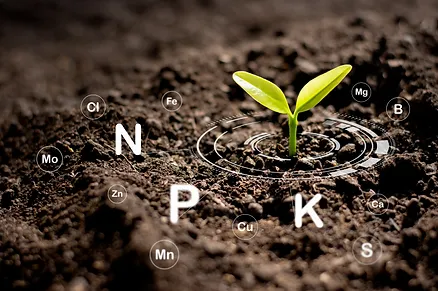Pushing the Limits: Why Commercial Growers Need to Adopt a Scientific Approach to Nutrients.

The term N-P-K is often thrown around like they are the ABC’s of nutrients, which in a way they are. These three nutrients provide the foundation for what plants need to thrive. Using a prepared N-P-K mixture is similar to popping a multivitamin. This strategy provides the basics (allowing your plant to survive), but it really does not respond to the specific nutrient needs of your growing environment without manipulation. No two growing situations are identical.
Lighting, growing medium, cultivars, and stage of growing are all factors that will have an effect on the amount (and type) of nutrients that are needed. So instead of tossing in a generic formula, why not give the cannabis plants exactly what they are missing?
In this piece, we are going to explore two of the more critical nutrients: Nitrogen (N) and Phosphorus (P), and how they alter the development of cannabis.
How much is enough? And can there be too much of a good thing?
NITROGEN (N)
Nitrogen (N) plays many roles in the cannabis plant including aiding with the overall metabolism, building protein, chlorophyll and nucleic acid synthesis. This valuable mineral is a critical part to photosynthesis, root development and overall plant growth. In addition, nitrogen helps take in and transport other plant minerals throughout the plant. Understanding the amount of available nitrogen for the cannabis plant is critical to help regulate the overall growth of the plant. So, what is that level that will help ensure that your cannabis plants get exactly what they need?
PUT IT TO THE TEST
Saloner and Bernstein (2020) wanted to discover how the cannabis plant responded to nitrogen supply in the vegetative growth phase. Their study involved growing plants in different ranges of nitrogen levels ranging from 30mgL up to 240 mgL to determine what the optimal level of nitrogen was.
Their results revealed that cannabis plants showed signs of nitrogen deprivation when the available levels were less than 80mgL. Nitrogen deficiency resulted in restricted growth and development and leaf chlorosis, including the cannabis plants struggling with being able to produce lower stem radial growth, side branch elongation, and healthy root biomass accumulation. In addition, not enough nitrogen in the plant cells, resulted in restricted cell metabolism, a reduction in most of the plant processes and developmental delays.
What was interesting is that the plant reacted similarly when the levels of nitrogen were too high, over 160 ml/L, including a decline in photosynthesis levels resulted in stomatal closure and reduction in stomatal conductance, transpiration rate and intercellular carbon dioxide levels. Once the supply of nitrogen exceeded 240 mg/L, the root development became restricted, and at high levels, 320 ppm, the plant showed signs of a nitrogen overdose including smaller plant and plant organs and a dark green colour.
Their research revealed that the optimal nitrogen levels for a typical cannabis plant appear to be between 80 mg/L to 160 mg/L. This is when the plant showed positive growth, overall morphology (side branch elongation and healthy root biomass), and coloration, with optimal leaf, shoot and root development.
The supply also affected the plant’s ability to produce proteins, showing the clear connection between nitrogen levels, chlorophyll connections and photosynthesis.
Be strategic when you’re adding nitrogen. Adding in nitrogen during the flowering stage, for example, could lead to nitrogen toxicity (as the plant doesn’t need much of this mineral during this phase of growing).
THE TAKEAWAY
Carefully monitor your Nitrogen levels. This includes testing your soil and leaves regularly, to discover your nitrogen baseline, and adding only the inputs that your cultivar needs.
 PHOSPHORUS (P)
PHOSPHORUS (P)
Phosphorus (P) is a macronutrient that is needed for many of the central processes of plant growth and functionality, including healthy root development, stem growth and assisting with the flowering phase. This long chain fatty acid is closely bound to calcium. In fact, calcium helps maintain its structure, membrane permeability and overall homeostasis.
The phosphorus molecules are an essential part of the plant’s structure, they make up the backbones of both DNA and RNA, store energy, and help convert the genetic material in the plant to proteins.
Cannabis requires a lot of phosphorus. In fact, phosphorus starvation is a common challenge in the industry including slow growth and small leaves. When cannabis doesn’t have any phosphorus, the plants will struggle with developing both the roots and shoots that are needed for healthy development. This has led to the general belief that high concentrations of phosphorus are needed for the plant to function at its optimal level and to maximize the yield. But can there be too much of a good thing?
PUT IT TO THE TEST
Bernstein and Shiponi (2021) wanted to test this theory out, so they exposed cannabis to five different levels of phosphorus, ranging from 5 to 90 mg). In this study, plants that received less than 5 mg. of the nutrient were shorter with less nodes. But that’s not all, low phosphorus levels resulted in the plants not being able to uptake and move the nitrogen, potassium and other micronutrients including magnesium, calcium, iron and manganese throughout the plant.
However, too much phosphorus seems to impact the plant’s ability from absorbing and transporting the other minerals throughout the plant. So yes, with phosphorus, there can be too much of a good thing.
Although it’s still unclear how much phosphorus is too much, the recommended dose tends to be around 30mg/L. That number does not take into condition your specific growing conditions. Research suggests that there is a wide range of optimal levels of phosphorus for cannabis, which will vary according to the cultivars. That being said, what we do know about plant morphology and development is that the key with nutrients is ensuring that there is a healthy balance.
THE TAKEAWAY
Phosphorus plays a critical role throughout all stages of growing. This mineral will not only provide cannabis with a strong foundation, it also helps transport the other micronutrients throughout the plant. However, there can be too much of a good thing, so monitor your phosphorus levels carefully to make sure that your plant is getting the right balance of nutrients.
Although it’s easy to just use a premixed formula, this method could limit your plant’s potential. Playing an active role in adding inputs, including regular monitoring, will help ensure that you give your plant exactly what it needs to thrive.. Phosphorus and Nitrogen are just two of the necessary nutrients for healthy cannabis growth.
In our next post,
Aelius LED will explore the role of potassium (K) and why growers should also consider micronutrients, including calcium, magnesium and iron, for a thriving production.


 PHOSPHORUS (P)
PHOSPHORUS (P)

